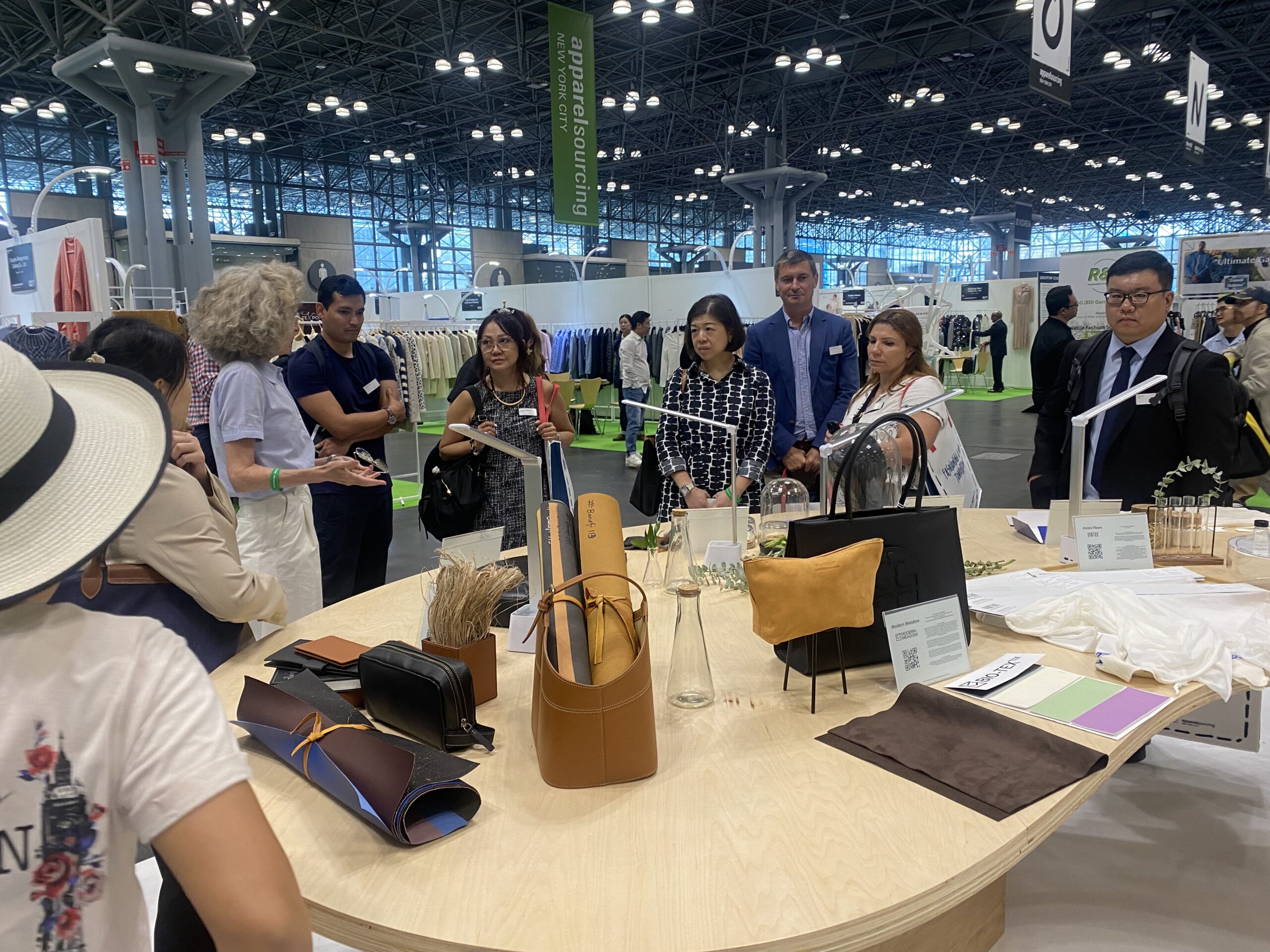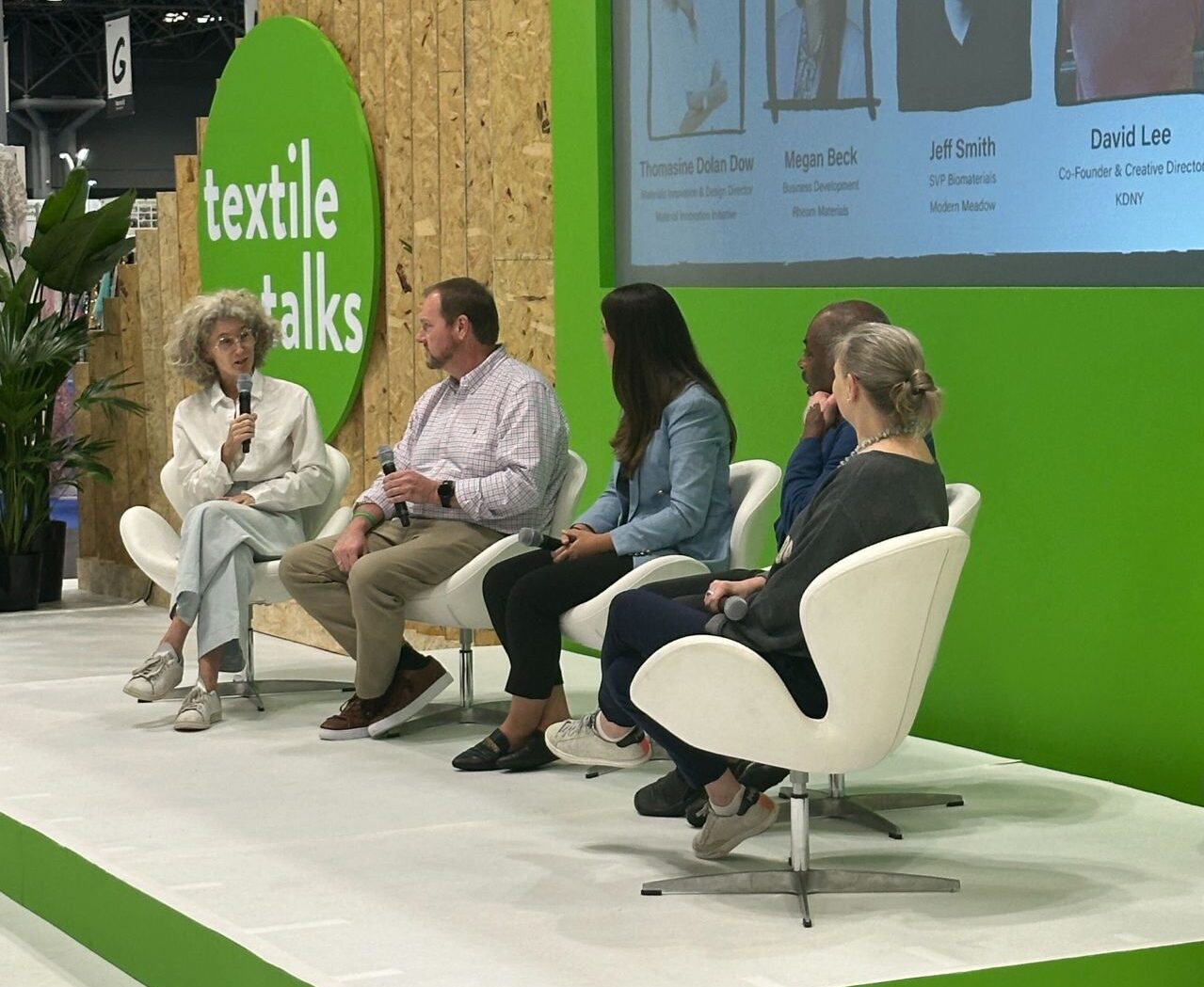“I want to make sure that people understand that this is all on its way to being scaled. It’s not just a dream.” — Thomasine Dolan Dow, Director of Materials Innovation and Design, Material Innovation Initiative.

Texworld visitors explore the Material Innovation Hub.
At Texworld NYC’s July event, attendees explored cutting-edge textile advancements at the Material Innovation Initiative’s (MII) Material Innovation Hub.
Texworld NYC, a premier biannual event, partnered with MII for the second time this year to showcase innovations replacing petrochemical- and animal-based materials. The Material Innovation Hub was a focal point for sustainable solutions. MII’s Director of Materials Innovation and Design, Thomasine Dolan Dow, who ran the Hub, says “it is raising awareness and giving access to a broader group of people who didn’t know this was happening.”
Though Texworld is dominated by mainstream apparel, brands like IKEA, Everlane, Allbirds, and Tory Burch also visited the Hub. Dow remarked, “people would stop by and have their hair blown back because they had no idea this was going on.”
Dow, who is no stranger to Texworld coming from a background in fashion design, says of the thousand visitors to the hub, “it was really meaningful, and [they] pointedly came.” Next-gen materials were new to many, but their reaction was positive. “It became this happy zone,” she reminisced, “it was the ‘Innovation Hub’, but it was this ‘Optimistic Hub’ because everyone felt there is hope in the world,” she added laughingly.
The Hub showcased solutions to fashion’s sustainability challenges. On display were swatches, prototypes, material inputs, and information on 15 featured innovators. Some, like olive-waste leather producer Oleago from Turkey, were present in person. Dow recalls, “people were staying for 15, 20 minutes. No one ever stays for that long at a booth.”
When it comes to choosing innovators for the event, Dow seeks balance between next-gen silk, wool, down, and fur—not just next-gen leather, despite its preponderance in the market. She also goes for a range of developmental stages, “I try to have a mix of people who are still in R&D and those who are commercial, so that people can make the leap, and not just look at this and go “This’ll be ten years from now. I want to make sure that people understand that this is all on its way to being scaled. It’s not just a dream.”

Dow, far left, talks to visitors at the Hub.
Key Innovations
NFW, a commercially-scaled innovator, and von Holzhausen, who recently collaborated with Herman Miller on a bamboo-leather version of the iconic Eames Chair, were also showcased. “That’s the kind of iconic and widely recognized stuff we need,” Dow says.
A standout innovation was Modern Meadow‘s next-gen suede, which Dow notes is rare. “I’m not aware of other next-gen leather makers who have created suedes.” Kintra Fibers, who produce a biobased polyester that can mimic silk and cashmere, showed notable progress since the January Hub, having three times as many swatches and a finished garment.
Dow, with MII since its inception, has seen many innovators evolve. “I love them all. They’re so into what they do,” she says. She recalls how the founder of Rheom Materials, “actually came to my apartment in the early stages [with initial swatches]. Fast forward now to 2024, he had a beautiful next-gen leather swatch that I saw made into a bag. [I was] blown away.” Rheom’s iterations also led to biobased pellets for injection molding, showing how next-gen advancements can lead to breakthroughs elsewhere.
Similarly, Hydefy, who were also on display, started life as a plant-based protein start-up before expanding into next-gen materials. They now create both next-gen leather and novel material swatches, the latter Dow says “is a great idea. “It can be tricky to say “Oh, it’s just like leather,” whereas if you just call it a novel material, it’s brand new and nobody can take shots at that.”

Dow in conversation with (from left to right) Jeff Smith, Modern Meadow, Megan Beck, Rheom Materials, David Lee, KD New York, Jennie McCarthy, Ethos Matters.
Challenges
Texworld is also known for its engaging panel discussions. Dow’s panel, “Exploring Innovation and Sustainable Next-Gen Materials,” featured three innovators, plus ESG Specialist Jennie McCarthy. They discussed the painstaking “boots-on-the-ground” journey of considering everything from where a fiber is carded, to worker’s healthcare. Dow added “if it’s truly going to meet the SDGs [etc.] you have to go all the way back to the source.” Traceability is time-consuming and costly, so brands avoid it. But the impending Fashion Act could change that.
Finances are another perennial challenge for innovators. They “have to go through constant iterations to see where they are with their product. Everything’s an expense.” Knowing the right time to use intellectual property lawyers is another financial strain. MII will host a webinar on the topic this fall, which Dow is sure will be valuable. Their recent webinar on material tariffs revealed to Dow how “there’s no incentivization on any of this. There’s no special treatment for sustainable materials, let alone next-gen materials.”
Dow also stressed the importance of a material company’s branding, adding, “that goes a long way. If you’re from a fashion company and you have a certain taste level and then you find someone who is presenting something that speaks to you on your aesthetic level, you can have conversations because you’re going to speak the same language. When you look at materials, you want to see a good presentation.” How does she advise innovators to up their design game? Hire an expert, this could be for a range of design disciplines, and “always elevate, even if you’re selling to the mass market. Brands want to buy into something that looks elevated. Everybody is drawn to things that are aspirational.”
The textile industry’s evolution, highlighted by the Material Innovation Hub, offers a glimpse into a more sustainable, humane future. Dow remains optimistic, stating, “it’s growing and I hope that Texworld continues to do the right thing by seizing this moment.”
Sign up for MII’s upcoming webinar on intellectual property on September 26, 2024 here.
